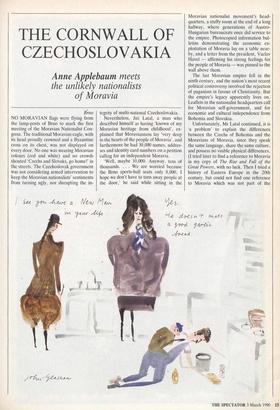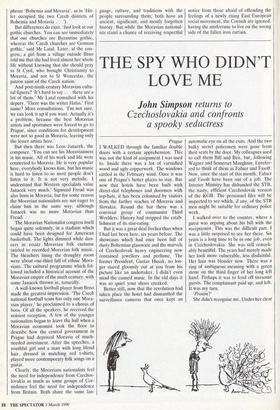THE CORNWALL OF CZECHOSLOVAKIA
Anne Applebaum meets
the unlikely nationalists of Moravia
Brno NO MORAVIAN flags were flying from the lamp-posts of Brno to mark the first meeting of the Moravian Nationalist Con- gress. The traditional Moravian eagle, with its head proudly crowned and a Byzantine cross on its chest, was not displayed on every door. No one was wearing Moravian colours (red and white) and no crowds shouted 'Czechs and Slovaks, go home!' in the streets. The Czechoslovak government was not considering armed intervention to keep the Moravian nationalists' sentiments from turning ugly, nor disrupting the in-
tegrity of multi-national Czechoslovakia.
Nevertheless, Jiri Latal, a man who described himself as having 'known of my Moravian heritage from childhood', ex- plained that Moravianncss lay 'very deep in the hearts of the people of Moravia', and furthermore he had 30,000 names, addres- ses and identity card numbers on a petition calling for an independent Moravia.
'Well, maybe 10,000. Anyway, tens of thousands. . . . We are worried because the Brno sports-hall seats only 8,000, I hope we don't have to turn away people at the door,' he said while sitting in the
Moravian nationalist movement's head- quarters, a stuffy room at the end of a long hallway, where generations of Austro- Hungarian bureaucrats once did service to the empire. Photocopied information bul- letins demonstrating the economic ex- ploitation of Moravia lay on a table near- by, and a letter from the president, Vaclav Havel — affirming his strong feelings for the people of Moravia — was pinned to the wall above them.
The last Moravian empire fell in the ninth century, and the nation's most recent political controversy involved the rejection of paganism in favour of Christianity. But the empire's legacy apparently lives on. Leaflets in the nationalist headquarters call for Moravian self-gdvernment, and for economic and cultural independence from Bohemia and Slovakia.
Unfortunately, Mr Latal continued, it is 'a problem' to explain the differences between the Czechs of Bohemia and the Moravians of Moravia, since they speak the same language, share the same culture, and possess no visible physical differences. (1 tried later to find a reference to Moravia in my copy of The Rise and Fall of the Great Powers, with no luck. Then I tried a history of Eastern Europe in the 20th century, but could not find one reference to Moravia which was not part of the
phrase 'Bohemia and Moravia', as in 'Hit- ler occupied the two Czech districts of Bohemia and Moravia . . .').
But differences do exist. 'Just look at our gothic churches. You can see immediately that our churches are Byzantine gothic, whereas the Czech churches are German gothic,' said Mr Latal. Later, at the con- gress, a girl from a village outside Brno told me that she had lived almost her whole life without knowing that she should pray to St Cyril, who brought Christianity to Moravia, and not to St Wenceslas, the patron saint of the Czech nation.
And post-ninth-century Moravian cultu- ral figures? 'It's hard to say . . . there are a lot of them.' Mr Latal consulted with his deputy. 'There was the writer Halas.' First name? More consultations. 'I'm not sure, we can look it up if you want. Actually it's a problem, because the best Moravian artists and sportsmen were forced to go to Prague, since conditions for development were not so good in Moravia, leaving only the lesser artists here.'
But then there was Leos Janacek, the composer. 'You can see his Moravianness in his music. All of his work and life were connected to Moravia. He is very popular here, everybody knows him, but his music is hard to listen to so most people don't listen to it. It is not very melodic. I understand that Western specialists value Janacek very much.' Sigmund Freud was also born in Moravia, but for some reason the Moravian nationalists are not eager to claim him in the same way, although Janacek was no more Moravian than Freud.
The Moravian Nationalist congress itself began quite solemnly, in a stadium which could have been designed for American basketball. The lights dimmed while dan- cers in ersatz Moravian folk custume twirled to recorded Moravian folk music. The bleachers lining the draughty room were about one-third full of ethnic Mora- vians. The cultural programme which fol- lowed included a historical account of the Moravian empire of the ninth century, with some Janacek thrown in, naturally.
A well-known football player from Brno made the greatest impression. 'The Czech national football team has only one Mora- vian player,' he proclaimed to a chorus of boos. Of all the speakers, he received the noisiest reception. A few of the younger nationalists began to leave the hall when a Moravian economist took the floor to describe how the central government in Prague had deprived Moravia of much- needed investment. After the speeches, a youthful girl and a man with long blond hair, dressed in matching red t-shirts, played more contemporary folk songs on a guitar.
Clearly, the Moravians nationalists feel the need for independence from Czechos- lovakia as much as some groups of Cor- nishmen feel the need for independence from Britain. Both share the same lan- guage, culture, and traditions with the people surrounding them; both have an ancient, significant, and mostly forgotten history. But while the Moravian national- ists stand a chance of receiving respectful
notice from those afraid of offending the feelings of a newly rising East European social movement, the Cornish are ignored, having the misfortune to live on the wrong side of the fallen iron curtain.



























































 Previous page
Previous page